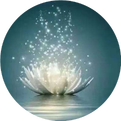
The meridians are an important organizational structure of the human body, playing a crucial role in the transmission of information and other vital activities. Many people ask, do meridians really exist? Why can’t we see or touch them like blood, muscles, or bones?
Meridians certainly exist, and they serve as pathways for the flow of Qi and blood, facilitating communication and conduction. The acupuncture and massage techniques we commonly use follow these meridians. Therefore, understanding meridians, from basic knowledge to practical application, is essential for practitioners such as lactation consultants.
As we all know, there are twelve primary meridians in the human body, which are commonly referred to as the Twelve Meridians. In this article, we will learn about the distribution patterns of the meridians and their interior-exterior relationships.
1. Hand Taiyin Lung Meridian (Shou Taiyin Fei Jing)
The Hand Taiyin Lung Meridian begins in the middle jiao, descends to connect with the Large Intestine, and returns to circulate around the stomach (lower orifice pylorus, upper orifice cardia), ascends through the diaphragm, belongs to the Lung, and rises to the throat, running parallel to the upper chest (Zhongfu point), superficially emerging under the armpit, descending along the inner edge of the upper limb, passing through the axilla, entering the wrist (Cun point), and ascending to the thumb’s radial side (Shaoshang point).
Branch: It branches from the back of the wrist (Lieque point), running towards the radial side of the index finger (Shangyang point), intersecting with the Hand Yangming Large Intestine Meridian.
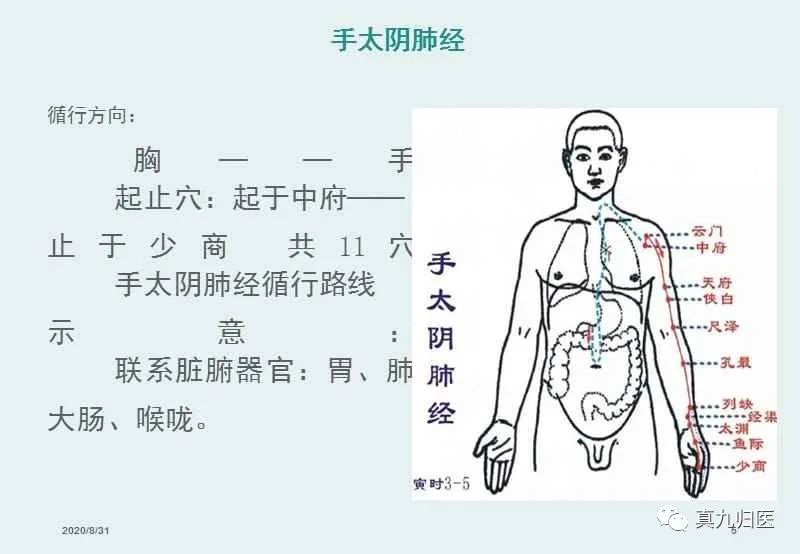
2. Hand Yangming Large Intestine Meridian (Shou Yangming Da Chang Jing)
It begins at the radial side of the index finger (Shangyang point), ascends along the dorsal side of the index finger, passes through the Hegu point, runs along the anterior edge of the upper limb, reaches the anterior edge of the shoulder joint, moves backward to the seventh cervical vertebra (Dazhui point), then descends into the supraclavicular fossa (Quepen point), enters the thoracic cavity to connect with the Lung, and descends through the diaphragm, belonging to the Large Intestine.
Branch: It descends from the supraclavicular fossa, travels through the neck to the cheek, enters the lower teeth, exits from the sides of the mouth, encircles the lips, intersects at the philtrum (Renzhong point) on both sides, and ascends to the adjacent side of the opposite nostril (Yingxiang point), intersecting with the Foot Yangming Stomach Meridian.
The Hand Yangming Large Intestine Meridian and the Hand Taiyin Lung Meridian are interrelated; the Hand Yangming Large Intestine Meridian is exterior, while the Hand Taiyin Lung Meridian is interior.
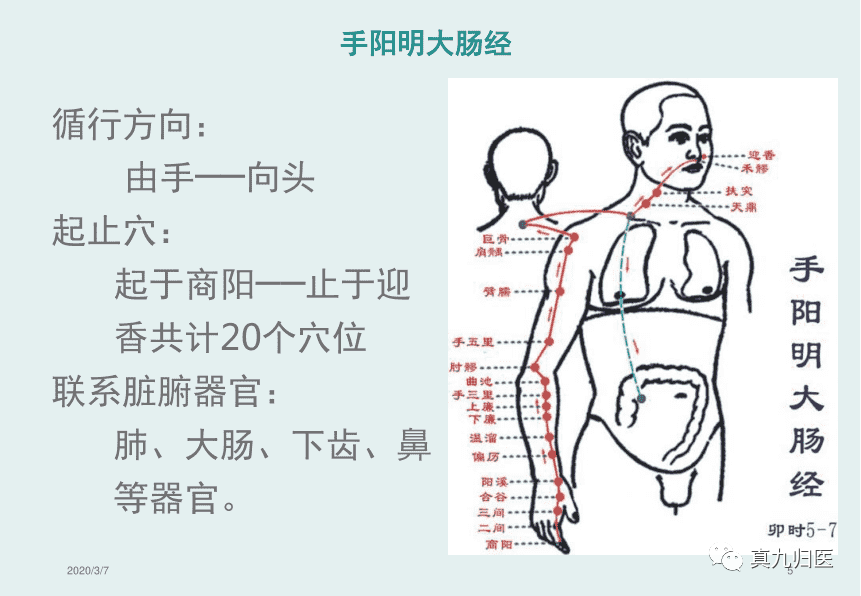
3. Foot Yangming Stomach Meridian (Zu Yangming Wei Jing)
It begins at the side of the nostril (Yingxiang point), ascends alongside the nose, converges at the root of the nose, enters the inner canthus of the eye, intersects with the Foot Taiyang Bladder Meridian, descends along the outer side of the nasal column, enters the upper teeth, exits from the sides of the mouth, encircles the lips, intersects at the Chengjiang point on both sides, and bends back along the lower jawbone to the jaw angle (Jiaoche point), ascends to the front of the ear, passes through the Shangguan point, and follows the hairline to the forehead.
Branch: It branches from the Dajing point below the lower jaw, descends to the Renying point, travels down the throat to the Dazhui point, bends forward to the Quepen point, enters the thoracic cavity, descends through the diaphragm, belongs to the Stomach, and connects with the Spleen.
Direct pathway: It descends from the Quepen along the midline of the breast, flanking the navel (2 cun lateral), and descends to the Qijie point in the groin.
Branch: It branches from the pylorus, descends through the abdominal cavity to the Qijie point, merges with the pathway, then descends along the anterior side of the thigh to the knee, along the anterior edge of the tibia to the dorsum of the foot, and enters the outer side of the second toe (Lidui point).
Branch: It branches from 3 cun below the knee (Zusanli point), descends to the dorsum of the foot, and enters the outer side of the middle toe.
Branch: It branches from the Chongyang point on the dorsum of the foot, enters the inner side of the big toe (Yinbai point), intersecting with the Foot Taiyin Spleen Meridian.
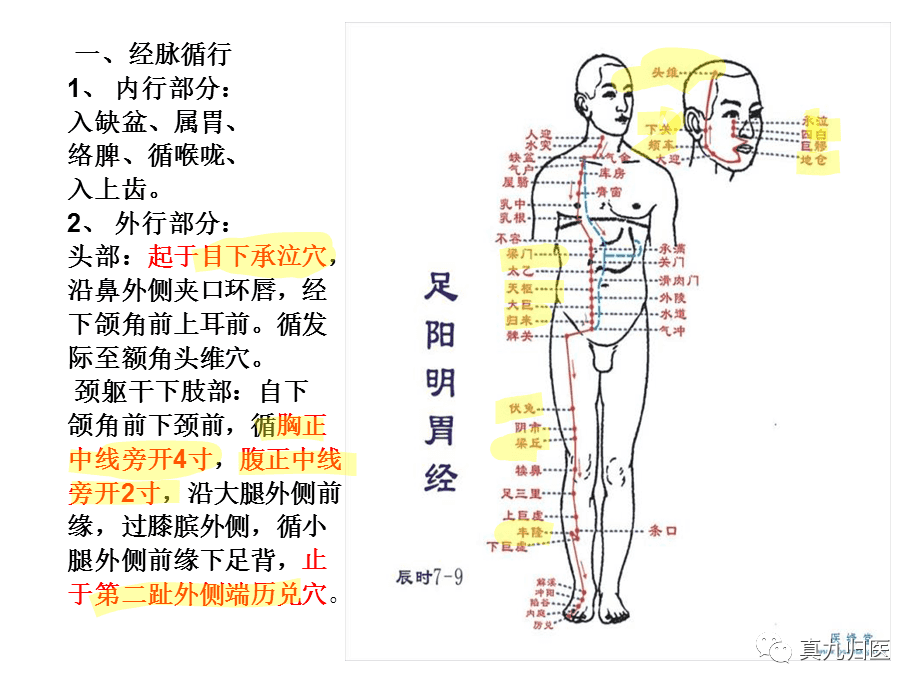 4. Foot Taiyin Spleen Meridian (Zu Taiyin Pi Jing)
4. Foot Taiyin Spleen Meridian (Zu Taiyin Pi Jing)
It begins at the inner side of the big toe (Yinbai point), travels along the inner side of the foot, passes the anterior edge of the inner ankle, ascends along the midline of the inner leg, reaches 8 cun above the tip of the inner ankle, branches out before intersecting with the Foot Jueyin Liver Meridian, ascends along the anterior edge of the inner thigh, and reaches the abdomen, belonging to the Spleen, connecting with the Stomach, then ascends through the diaphragm, along both sides of the esophagus, connecting to the root of the tongue, and dispersing under the tongue.
Branch: It branches from the Stomach, ascends through the diaphragm, enters the Heart, and intersects with the Hand Shaoyin Heart Meridian.
The Foot Yangming Stomach Meridian and the Foot Taiyin Spleen Meridian are interrelated; the Foot Yangming Stomach Meridian is exterior, while the Foot Taiyin Spleen Meridian is interior.
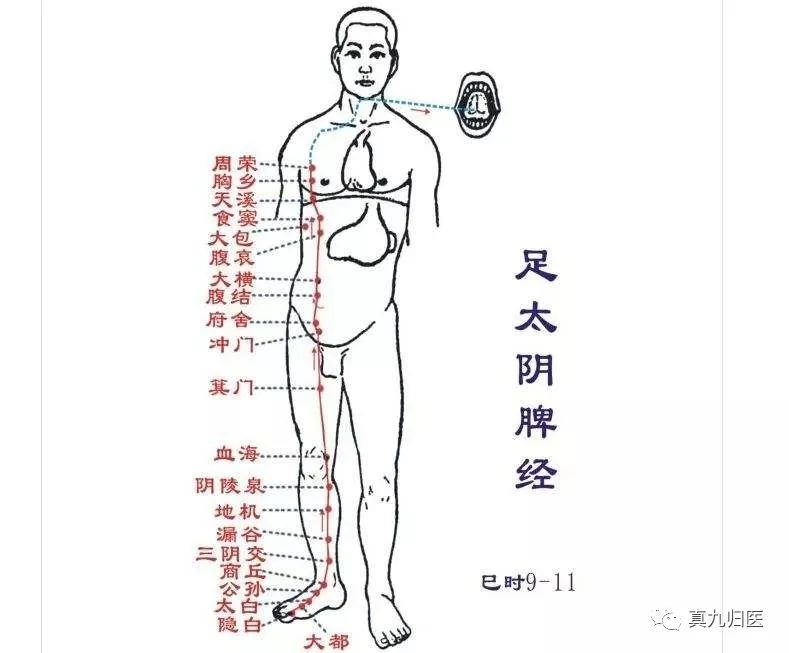
5. Hand Shaoyin Heart Meridian (Shou Shaoyin Xin Jing)
It begins in the Heart, exits to connect with the Pericardium, and sequentially connects with the Upper, Middle, and Lower Jiao.
Branch: It branches from the Heart, runs alongside the esophagus and throat, and connects to the eye system.
Direct pathway: It branches from the Heart, ascends into the Lung, traverses horizontally and descends within the Lung, superficially emerging under the armpit (Jiquan point), travels along the inner edge of the upper limb, passes through the elbow, enters the palm, along the radial side of the little finger, and exits at the radial side of the little finger (Shaochong point), intersecting with the Hand Taiyang Small Intestine Meridian.
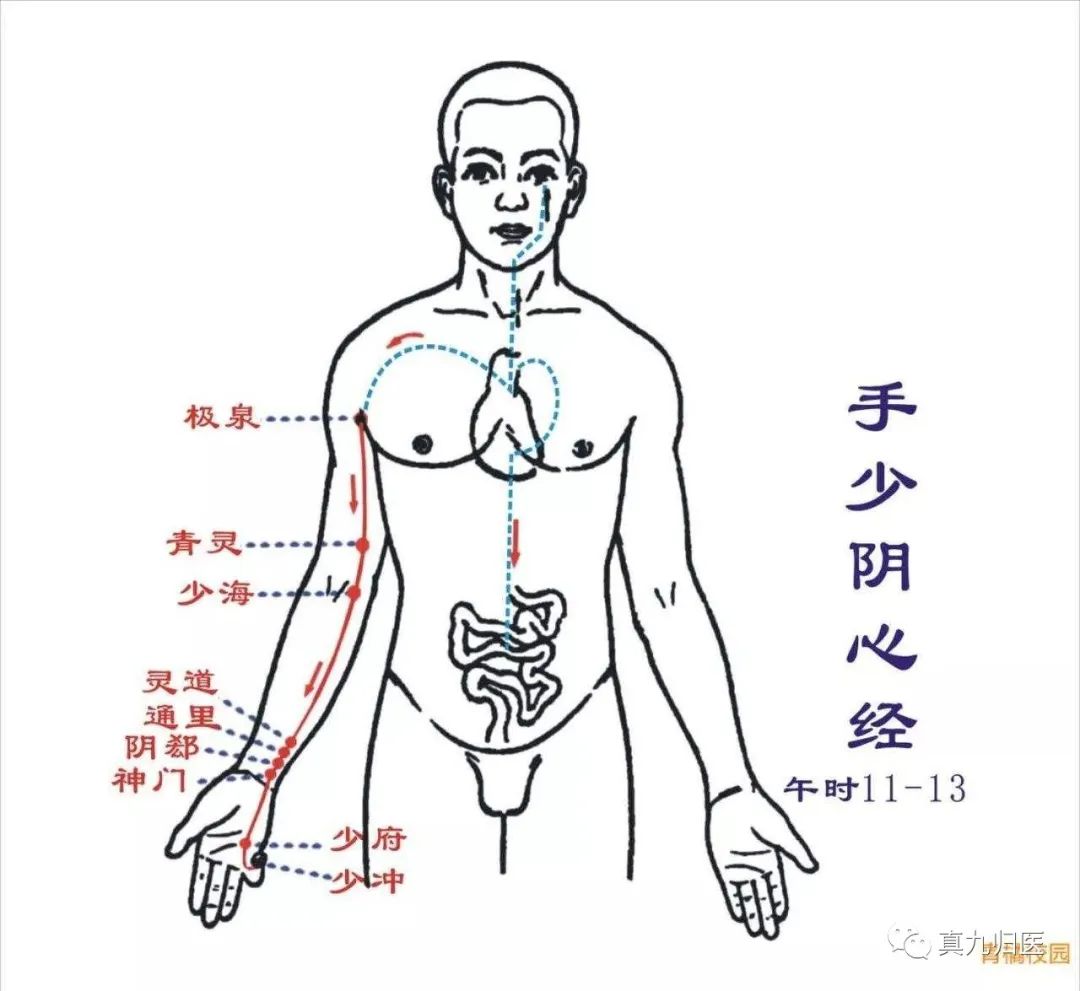
6. Hand Taiyang Small Intestine Meridian (Shou Taiyang Xiao Chang Jing)
It begins at the ulnar side of the little finger (Shaoze point), enters the wrist from the ulnar side, ascends along the outer edge of the forearm, passes through the elbow, reaches the back of the shoulder joint, wraps around the scapula, intersects at the Dazhui point, then moves forward into the Quepen, enters the thoracic cavity, connects with the Heart, descends through the esophagus, passes through the diaphragm, and reaches the Stomach, belonging to the Small Intestine.
Branch: It emerges from the Quepen, ascends through the neck to the cheek, reaches the outer canthus of the eye, bends into the ear (Tinggong point).
Branch: It branches from the cheek, ascends under the eye socket to the inner canthus (Jingming point), intersecting with the Foot Taiyang Bladder Meridian.
The Hand Taiyang Small Intestine Meridian and the Hand Shaoyin Heart Meridian are interrelated; the Hand Taiyang Small Intestine Meridian is exterior, while the Hand Shaoyin Heart Meridian is interior.
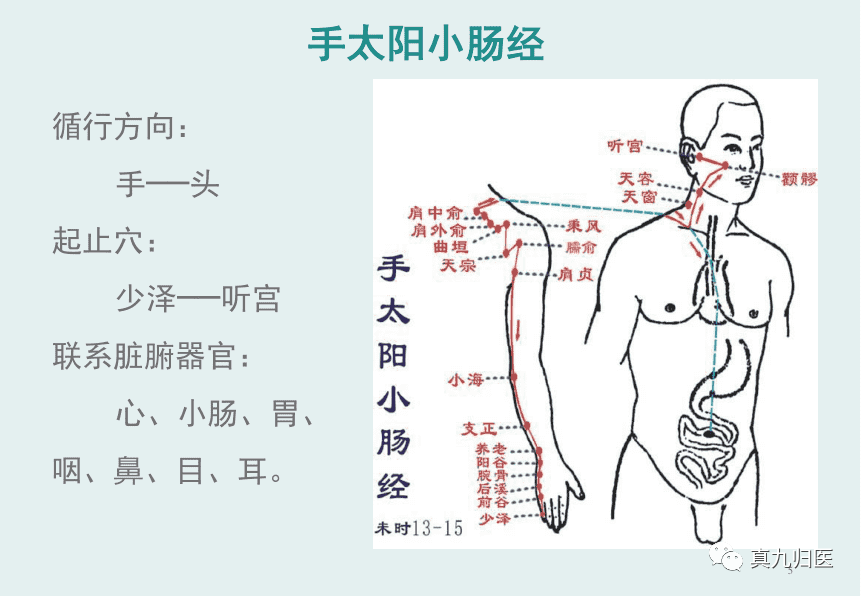
7. Foot Taiyang Bladder Meridian (Zu Taiyang Pang Guang Jing)
It begins at the inner canthus of the eye (Jingming point), ascends through the forehead, and converges at the top of the head (Baihui point).
Branch: It branches from the top of the head, descends to the side of the head at the upper corner of the ear.
Direct pathway: It branches from the top of the head, each descends to the occipital bone, enters the cranial cavity, connects with the brain, descends to the nape (Tianzhu point), and each divides into two branches.The inner branches descend and converge at the Dazhui point, then descend along the inner side of the scapula and along both sides of the spine (1.5 cun from the midline) to the lumbar region (Shenshu point), entering the muscles beside the spine, deeply affecting the body, belonging to the Bladder.
Branch: It branches from the lumbar region, descends along both sides of the spine, passes through the buttocks, and descends to the popliteal fossa (Weizhong point).
Branch: It branches from the neck (Tianzhu point), each descends along the outer side, passes through the inner edge of the scapula, descends to the hip joint (Huantiao point), and descends along the back of the thigh to the popliteal fossa, merging with the previous branch, then descends through the gastrocnemius muscle to the back of the outer ankle, bends forward along the outer edge of the foot to the outer side of the little toe (Zhiyin point), intersecting with the Foot Shaoyin Kidney Meridian.
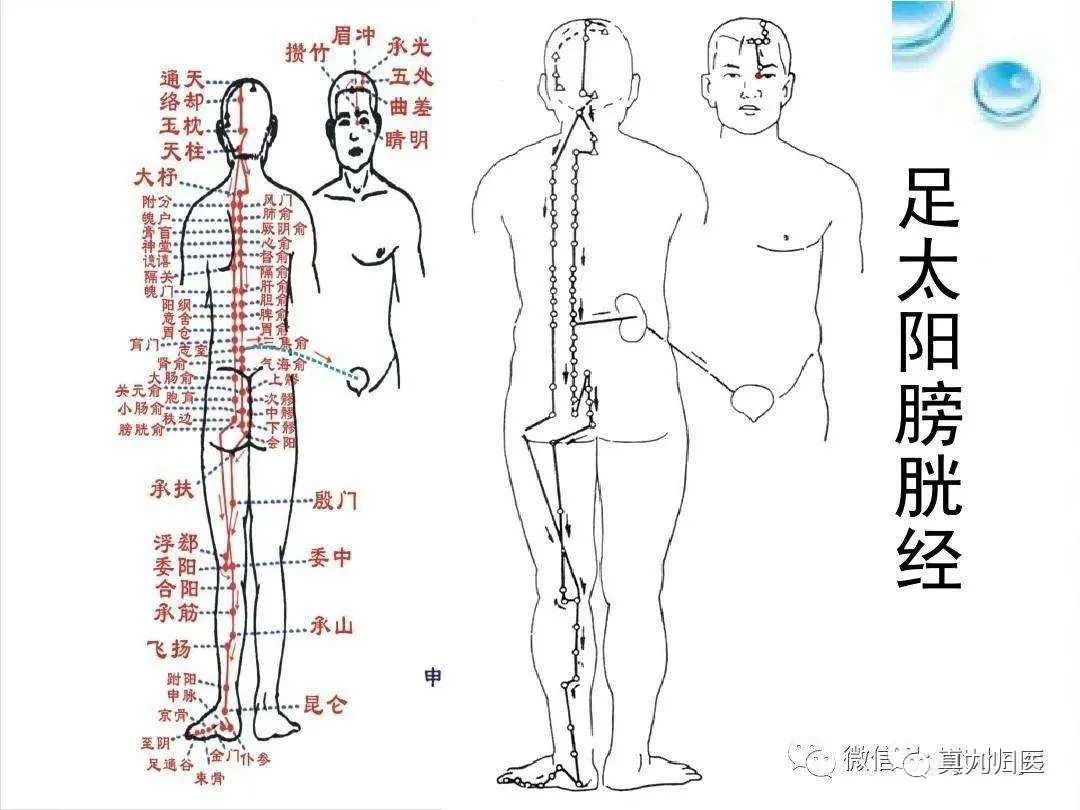
8. Foot Shaoyin Kidney Meridian (Zu Shaoyin Shen Jing)
It begins at the outer side of the little toe, diagonally traverses the sole of the foot (Yongquan point), exits beneath the tuberosity of the navicular bone (Rangu point), travels along the posterior side of the inner ankle, branches downward, enters the heel, ascends along the posterior edge of the inner leg, reaches the inner side of the popliteal fossa, directly ascends along the inner side of the thigh into the spine (Changqiang point), penetrates the spine to the lumbar region, belonging to the Kidney (superficial pathway: it also exits anteriorly, ascends along the midline of the abdomen 1.5 cun lateral, and the midline of the chest 2 cun lateral, reaching the lower edge of the clavicle at the Yufu point), connecting with the Bladder.
Direct pathway: It ascends from the Kidney, passes through the Liver and diaphragm, enters the Lung, travels along the throat, and reaches both sides of the root of the tongue.
Branch: It branches from the Lung, connects with the Heart, and enters the chest, intersecting with the Hand Jueyin Pericardium Meridian.
The Foot Taiyang Bladder Meridian and the Foot Shaoyin Kidney Meridian are interrelated; the Foot Taiyang Bladder Meridian is exterior, while the Foot Shaoyin Kidney Meridian is interior.
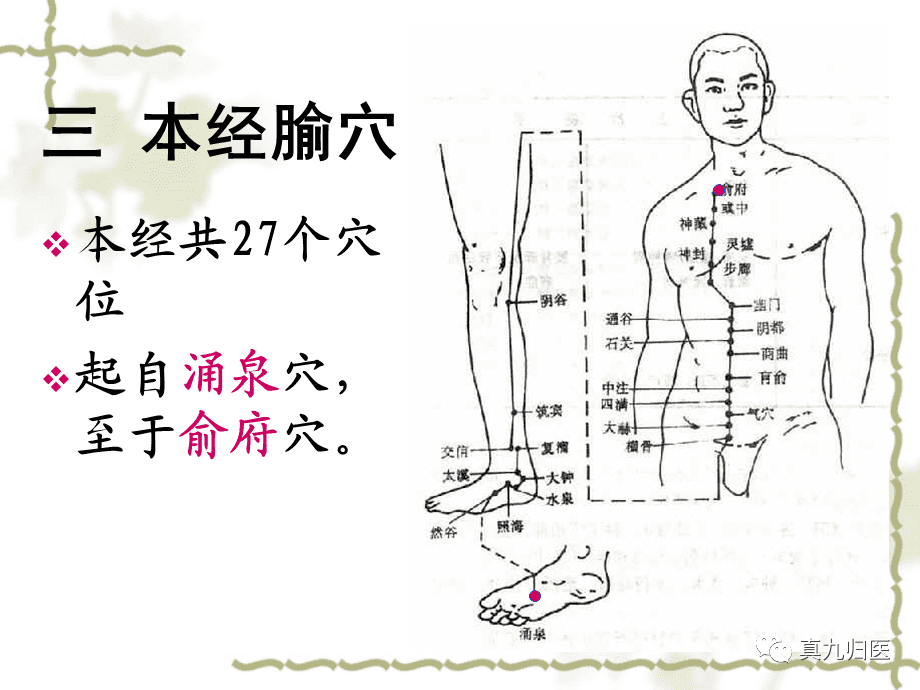
9. Hand Jueyin Pericardium Meridian (Shou Jueyin Xin Bao Jing)
It begins in the chest, exits to connect with the Pericardium, and sequentially connects with the Upper, Middle, and Lower Jiao.
Branch: It branches from the chest, horizontally travels to the ribs, emerges superficially 3 cun below the axilla (Tianchi point), ascends to the axilla, enters the inner side of the upper limb, descends along the forearm between the two tendons, passes through the wrist, enters the palm (Laogong point), travels along the radial side of the middle finger, and exits at the radial side of the middle finger (Zhongchong point).
Branch: It branches from the palm, travels along the inner side of the ring finger, and exits at the ulnar side of the ring finger (Guanchong point), intersecting with the Hand Shaoyang Sanjiao Meridian.
10. Hand Shaoyang Sanjiao Meridian (Shou Shaoyang San Jiao Jing)
It begins at the ulnar side of the ring finger (Guanchong point), ascends along the ulnar side, passes over the wrist, ascends between the ulna and radius, passes through the elbow, ascends along the outer side of the upper arm to the shoulder, moves forward into the Quepen, spreads in the chest, disperses the Pericardium, descends through the diaphragm, and connects with the Upper, Middle, and Lower Jiao.
Branch: It branches from the chest, ascends to the Quepen, travels through the shoulder to the nape, converges at the Dazhui point, and ascends to the nape, along the back of the ear (Yifeng point) to the upper corner of the ear, then curves downward around the cheek to the lower eye socket.
Branch: It branches from behind the ear, enters the ear, exits in front of the ear, and intersects with the previous branch at the outer canthus of the eye (Tongziliao point), intersecting with the Foot Shaoyang Gallbladder Meridian.
The Hand Jueyin Pericardium Meridian and the Hand Shaoyang Sanjiao Meridian are interrelated; the Hand Shaoyang Sanjiao Meridian is exterior, while the Hand Jueyin Pericardium Meridian is interior.
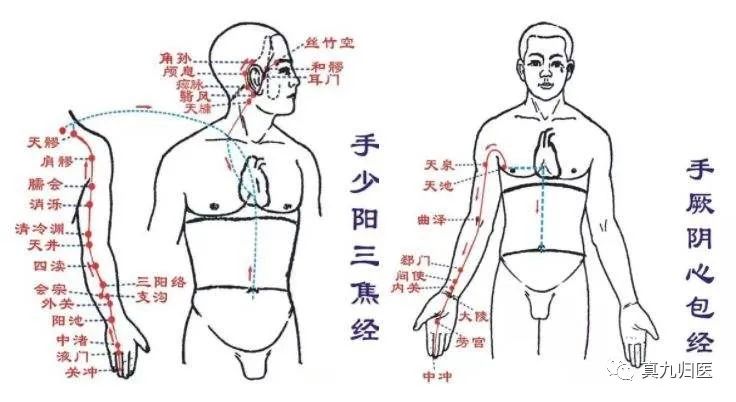
11. Foot Shaoyang Gallbladder Meridian (Zu Shaoyang Dan Jing)
It begins at the outer canthus of the eye (Tongziliao point), ascends to the corner of the forehead (Hanyan point), bends downward to the back of the ear (Wangu point), then bends upward, travels through the forehead to above the eyebrows (Yangbai point), bends backward to the Fengchi point, descends along the neck to the shoulder, converges at the Dazhui point, and moves forward into the Quepen.
Branch: It branches from the Wangu point behind the ear, enters the ear, exits in front of the ear, and reaches the outer canthus of the eye.
Branch: It branches from the outer canthus of the eye, descends to the lower jaw (Dajing point), connects with the branches of the Hand Shaoyang Meridian distributed in the cheek, returns to the lower eye socket, descends through the jaw angle (Jiaoche point), descends through the neck to the Quepen, and merges with the previous branch.Then it descends into the thoracic cavity, passes through the diaphragm, connects with the Liver, belongs to the Gallbladder, and superficially emerges at the Qijie point, encircling the pubic hair, horizontally reaching the hip joint (Huantiao point).
Direct pathway: It descends from the Quepen to the axilla, along the lateral chest, passes through the ribs, descends to the Huantiao point, merging with the previous branch.Then it descends along the outer side of the thigh, along the outer edge of the knee joint, travels along the anterior side of the fibula, directly descends to the lower end of the fibula (Xuanzhong point), passes in front of the outer ankle to the dorsum of the foot, and enters the outer side of the fourth toe (Zuqiaoyin point).
Branch: It branches from the dorsum of the foot (Zulinqi point), travels to the outer side of the big toe, then bends back, penetrating the nail, distributing to the back of the big toe nail, intersecting with the Foot Jueyin Liver Meridian.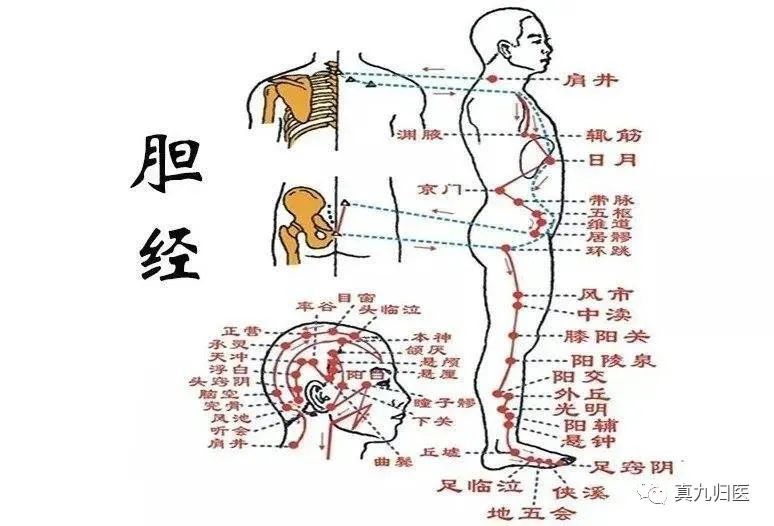
12. Foot Jueyin Liver Meridian (Zu Jueyin Gan Jing)
It begins at the back of the big toe nail, travels along the inner side of the foot to 1 cun anterior to the inner ankle (Zhongfeng point), then ascends along the anterior edge of the tibia, intersects with the Foot Taiyin Spleen Meridian 8 cun above the tip of the inner ankle, ascends along the inner side of the knee, along the midline of the inner thigh into the pubic region, encircles the genitals, descends to the lower abdomen, ascends through the Zhangmen point and Qimen point, enters the abdomen, flanking the Stomach, belongs to the Liver, connects with the Gallbladder, ascends through the diaphragm, spreads in the hypochondriac region, travels along the back of the throat, ascends into the nasopharynx, rises to connect with the eye system, exits at the forehead, and ascends to meet the Governing Vessel at the top of the head.
Branch: It branches from the eye system, descends into the cheek, encircles the lips.
Branch: It branches from the Liver, ascends through the diaphragm, enters the Lung, and intersects with the Hand Taiyin Lung Meridian.
The Foot Shaoyang Gallbladder Meridian and the Foot Jueyin Liver Meridian are interrelated; the Foot Shaoyang Gallbladder Meridian is exterior, while the Foot Jueyin Liver Meridian is interior.
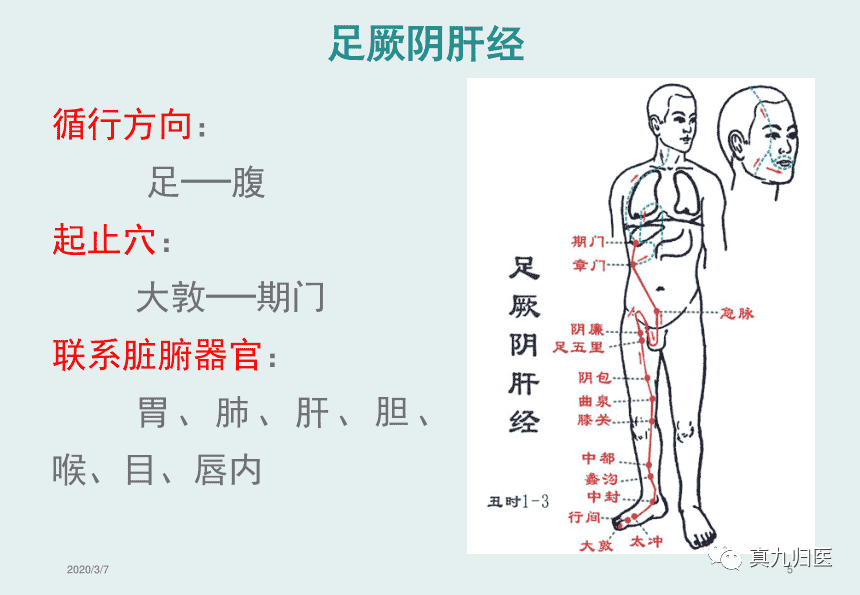
In a broad sense, the meridians in Traditional Chinese Medicine (TCM) are pathways for the flow of Qi and blood. Understanding the meridians allows practitioners to regulate Qi and blood as well as Yin and Yang through various methods such as massage, guided exercises, acupuncture, and physiotherapy, all of which are approached from the perspective of the meridians. The regulation of meridians and health maintenance is a form of “adjustment” that balances the body’s Yin, Yang, Qi, and blood. Meridians are an essential component of the foundational theories of TCM; although they are invisible and intangible, they continuously and universally influence the entire body. Only by mastering the pathways and functions of the meridians can one gain a more comprehensive understanding of them in future studies.
【Recommended Reading】
1: Diagnosis of Qi Flow in the North and South Meridians and the “Shanghan Lun”
2: Comparison Table of Blockages and Pain in the Twelve Meridians!
3: The Five Elements of China are Remarkable! (Cultural Roots)
4: Friends of TCM, do not let illness disturb you! (Including protective methods)
Follow our public account to learn more about TCM health knowledge, and add WeChat to join the learning group.


